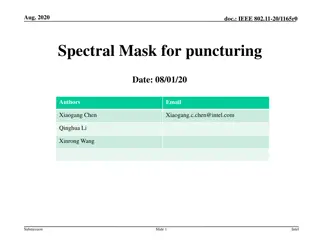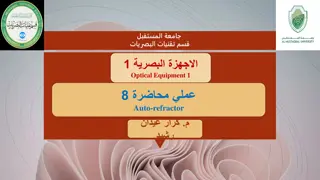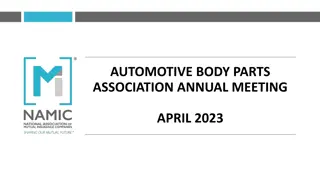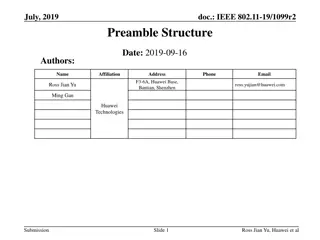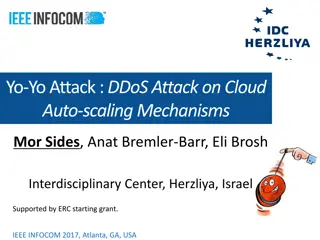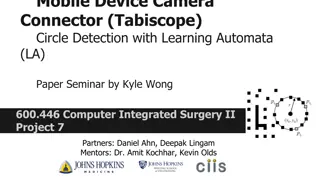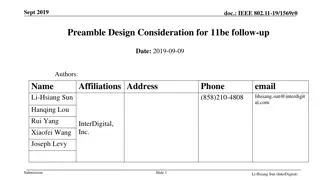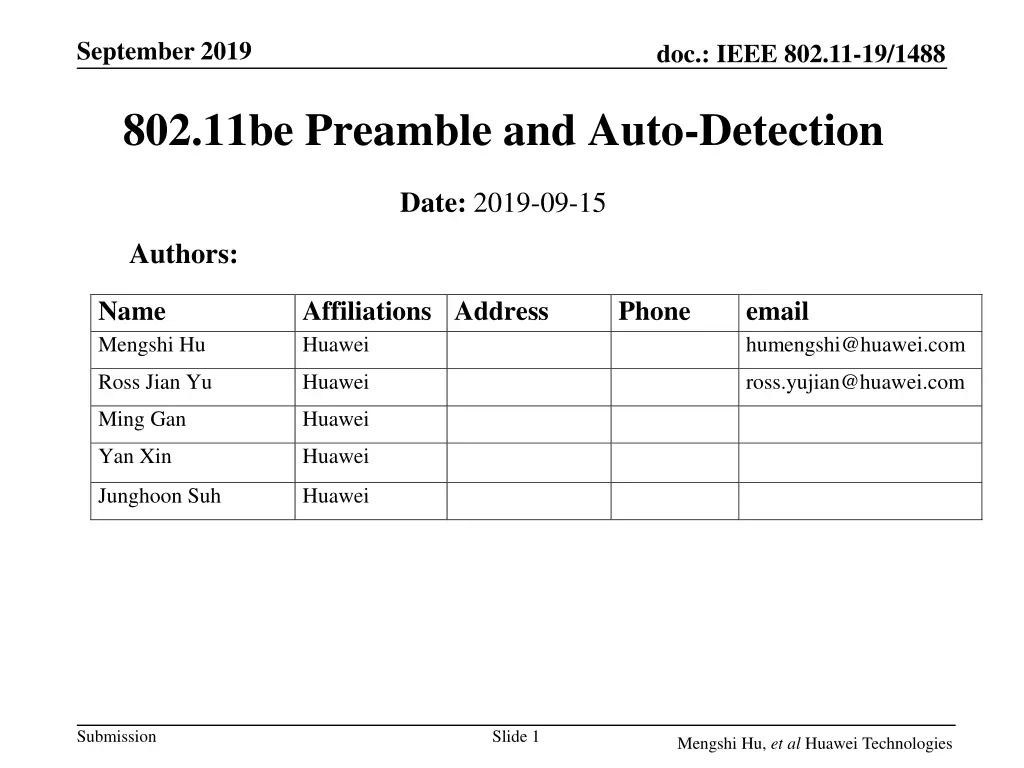
IEEE 802.11be Preamble Auto-Detection Analysis
Explore the analysis of three auto-detection options for IEEE 802.11be preamble, including methods like RL-SIG masking, signature symbols, and BPSK/QBPSK detection. The presentation delves into simulation results, observations, and conclusions regarding performance. Discover the implications of masked RL-SIG and combined-SIG for auto-detection in wireless communication standards.
Download Presentation

Please find below an Image/Link to download the presentation.
The content on the website is provided AS IS for your information and personal use only. It may not be sold, licensed, or shared on other websites without obtaining consent from the author. If you encounter any issues during the download, it is possible that the publisher has removed the file from their server.
You are allowed to download the files provided on this website for personal or commercial use, subject to the condition that they are used lawfully. All files are the property of their respective owners.
The content on the website is provided AS IS for your information and personal use only. It may not be sold, licensed, or shared on other websites without obtaining consent from the author.
E N D
Presentation Transcript
September 2019 doc.: IEEE 802.11-19/1488 802.11be Preamble and Auto-Detection Date: 2019-09-15 Authors: Name Mengshi Hu Affiliations Address Huawei Phone email humengshi@huawei.com Ross Jian Yu Huawei ross.yujian@huawei.com Ming Gan Huawei Yan Xin Huawei Junghoon Suh Huawei Submission Slide 1 Mengshi Hu, et al Huawei Technologies
September 2019 doc.: IEEE 802.11-19/1488 Introduction Previously, we share our views on 11be preamble structure [1]. In this contribution, we further give an analysis on three options of auto-detection for 11be. Several methods can be considered for auto-detection of 11be Using different patterns of RL-SIG mask the RL-SIG by a polarity sequence [2] Using a signature symbol [3] Detecting BPSK/QBPSK [4] Three options of auto-detection for 11be are analyzed: Give simulation results for these three options PER Miss detection False detection Show the observations and conclusions Submission Slide 2 Mengshi Hu, et al Huawei Technologies
September 2019 doc.: IEEE 802.11-19/1488 Recap: Auto-Detection BPSK BPSK/QPSK/... NON-HT (11a) ... L-STF L-LTF L-SIG Data ... BPSK QBPSK QBPSK HT-MF (11n) ... L-STF L-LTF L-SIG HT-SIG HT-STF QBPSK QBPSK ... HT-GF (11n) HT-GF-STF HT-LTF1 HT-SIG HT-LTF ... BPSK BPSK QBPSK VHT (11ac) ... L-STF L-LTF L-SIG VHT-SIG-A VHT-STF ... BPSK BPSK BPSK HE (11ax) ... L-STF L-LTF L-SIG RL-SIG HE-SIG-A BPSK BPSK BPSK WUR (11ba) ... L-LTF L-LTF L-SIG L-SIG L-SIG Auto-detection is implemented in the dashed rectangle. The main methods include detecting RL-SIG, detecting BPSK/QBPSK, checking SIG, etc. Submission Slide 3 Mengshi Hu, et al Huawei Technologies
September 2019 doc.: IEEE 802.11-19/1488 Three Options (1/2) Here we consider three options. TX RX BPSK BPSK ... ... L-STF L-LTF L-SIG RL-SIG ... L-STF L-LTF L-SIG RL-SIG ... Opt 0 Opt 0 Mask Mask BPSK BPSK QBPSK QBPSK ... ... L-STF L-LTF L-SIG RL-SIG ... Opt 1 L-STF L-LTF L-SIG RL-SIG ... Opt 1 Mask Mask BPSK BPSK BPSK BPSK ... ... L-STF L-LTF L-SIG RL-SIG ... Opt 2 L-STF L-LTF L-SIG RL-SIG ... Opt 2 Signature Signature Mask Mask Options Opt 0: Add a masked RL-SIG Opt 1: Add a masked RL-SIG and detect the modulation type (QBPSK) of the 1st symbol after the masked RL-SIG Opt 2: Add a masked RL-SIG and a signature symbol Note The red color on the right side represents that the corresponding modules are utilized for auto-detection Submission Slide 4 Mengshi Hu, et al Huawei Technologies
September 2019 doc.: IEEE 802.11-19/1488 Three Options (2/2) The used modules of different options are shown here Modules Detect RL-SIG Check Check Check signature Options combined-SIG BPSK/QBPSK Opt 0 (+Mask) Opt 1 (+Mask) (QBPSK) Opt 2 (+Mask) Detection modules Detect RL-SIG (by correlation values) Check combined-SIG (rate, length mod 3, parity) Detect BPSK/QBPSK Check signature Note that: All these options use combined-SIG for SIG checking (rate, length, parity) In Opt 0, 1 and 2, RL-SIG is multiplied by a polarity sequence to form a masked RL-SIG Signature design Here we compare 12 pre-defined bits as an example Submission Slide 5 Mengshi Hu, et al Huawei Technologies
September 2019 doc.: IEEE 802.11-19/1488 Simulation Configurations To show the performance of different options, we simulate them. Some simulation configurations are shown here. Bandwidth 20 MHz Channel model TGn/TGac UL/DL DL Channel condition NLOS Antennas 1x1 CFO 20 ppm Submission Slide 6 Mengshi Hu, et al Huawei Technologies
September 2019 doc.: IEEE 802.11-19/1488 PER Performance PER, 20MHz, 1x1 100 L-SIG (11a) Combined-SIG (11ax) Combined-SIG (Opt 0) 10-1 PER 10-2 10-3 10-4 -8 -6 -4 -2 0 2 4 6 8 SNR (dB) Compared with only decoding L-SIG, decoding combined-SIG achieves a better PER performance because of the combination of L-SIG and RL-SIG. Submission Slide 7 Mengshi Hu, et al Huawei Technologies
September 2019 doc.: IEEE 802.11-19/1488 Miss Detection Miss detection, 20 MHz, 1x1 100 L-SIG (11a, PER) Combined-SIG (Opt 0, PER) Miss (11ax) Miss (Opt 0) Miss (Opt 1) Miss (Opt 2) 10-1 Error prob. 10-2 10-3 10-4 -8 -6 -4 -2 0 2 4 6 8 SNR (dB) Here we show the performance on miss detection of different options. The performance of the first two options are mainly limited by checking combined- SIG, while the performance of Opt 2 is mainly limited by checking the signature. Submission Slide 8 Mengshi Hu, et al Huawei Technologies
September 2019 doc.: IEEE 802.11-19/1488 Miss and False Detection (Opt 0) Opt 0 100 Miss (Opt 0) False (11a) False (11n) False (11ac) False (11ax) False (11ba) 10-1 10-2 Error prob. 10-3 10-4 10-5 -5 0 5 10 15 SNR (dB) This figure shows the miss/false detection performance of Opt 0. Submission Slide 9 Mengshi Hu, et al Huawei Technologies
September 2019 doc.: IEEE 802.11-19/1488 Miss and False Detection (Opt 1) Opt 1 100 Miss (Opt 1) False (11a) False (11n) False (11ac) False (11ax) False (11ba) 10-1 10-2 Error prob. 10-3 10-4 10-5 -5 0 5 10 15 SNR (dB) This figure shows the miss/false detection performance of Opt 1. Obvious improvements in false detection can be achieved by detecting QBPSK. Submission Slide 10 Mengshi Hu, et al Huawei Technologies
September 2019 doc.: IEEE 802.11-19/1488 Miss and False Detection (Opt 2) Opt 2 100 Miss (Opt 2) False (11a) False (11n) False (11ac) False (11ax) False (11ba) 10-1 10-2 Error prob. 10-3 10-4 10-5 -5 0 5 10 15 SNR (dB) The performance of miss detection is mainly limited by the signature PER. A much better performance of false detection is achieved by Opt 2 Submission Slide 11 Mengshi Hu, et al Huawei Technologies
September 2019 doc.: IEEE 802.11-19/1488 Observations Option 1 Opt 1 has almost the same miss detection performance as Opt 0. Obvious improvements in false detection can be achieved by detecting QBPSK. Option 2 Opt 2 uses a pre-defined signature field to do auto-detection. The contents of the signature can be further discussed (e.g. standard version). Suggest to include CRC and Tail bits in the signature symbol to provide early detection. The performance of miss detection is mainly limited by the signature PER. A much better performance of false detection is achieved by Opt 2. Submission Slide 12 Mengshi Hu, et al Huawei Technologies
September 2019 doc.: IEEE 802.11-19/1488 Conclusions According to our observations, we propose the following format for auto-detection in 11be L-SIG + RL-SIG (variant) + signature symbol (QBPSK), which ensures both the miss detection and false detection performance. Submission Slide 13 Mengshi Hu, et al Huawei Technologies
September 2019 doc.: IEEE 802.11-19/1488 Straw Poll Do you agree to apply the following auto-detection methods for 11be: L-SIG + RL-SIG variant + signature symbol (QBPSK). RL-SIG variant is different from RL-SIG in 11ax. Exact RL-SIG variant details are TBD. Signature symbol contents are TBD. Submission Slide 14 Mengshi Hu, et al Huawei Technologies
September 2019 doc.: IEEE 802.11-19/1488 References [1] IEEE 802.11-19/1099r0 preamble structure in 11be [2] IEEE 802.11-19/1142 Discussion on the Preamble for 11be [3] IEEE 802.11-15/0643r0 auto-detection with signature symbol [4] IEEE 802.11-10/0549r2 TGac Preamble Auto-Detection Comparisons [5] IEEE 802.11-19/1214r0 Preamble Design Consideration for 802.11be [6] IEEE 802.11-19/1021r1 Preamble Design Harmonization [7] IEEE 802.11-19/1085r0 High-level EHT Preamble Structure Submission Slide 15 Mengshi Hu, et al Huawei Technologies




